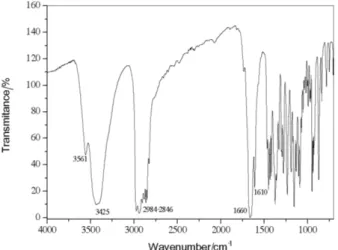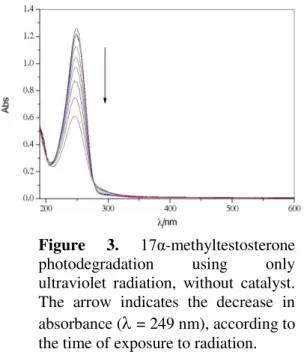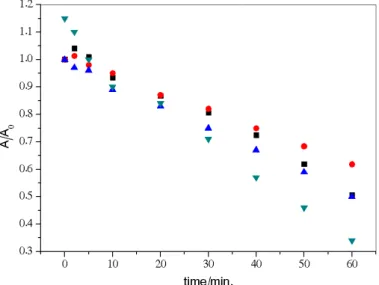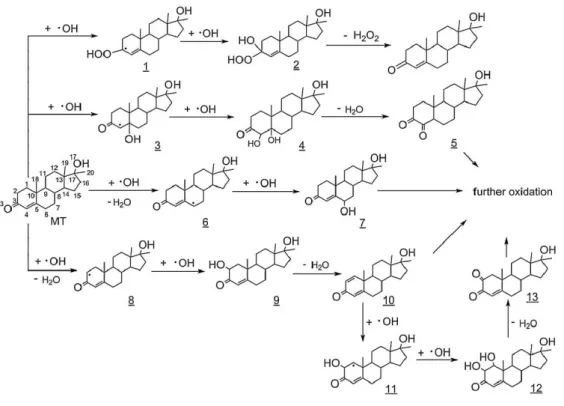ISSN 1980-993X – doi:10.4136/1980-993X www.ambi-agua.net
E-mail: ambi.agua@gmail.com
This is an Open Access article distributed under the terms of the Creative Commons Attribution License, which permits unrestricted use, distribution, and reproduction in any medium, provided the original work is properly cited.
Degradation of 17α
-methyltestosterone by hydroxyapatite catalyst
ARTICLES doi:10.4136/ambi-agua.2103Received: 03 Mar. 2017; Accepted: 29 Nov. 2017
Daniela Langaro Savaris1; Roberto de Matos2; Cleber Antonio Lindino1*
1Universidade Estadual do Oeste do Paraná (UNIOESTE), Toledo, PR, Brasil
Departamento de Química. E-mail: dani.savaris@hotmail.com, lindino99@gmail.com 2Universidade Estadual de Londrina (UEL), Londrina, PR, Brasil
Departamento de Química. E-mail: rmatosdqi@gmail.com *Corresponding author
ABSTRACT
Fish farming is becoming a highly profitable economic activity and the rearing of fingerlings involves the practice of sex reversal for the production of species (male) using the hormone 17α -methyltestosterone (MT). This study analyzed the methodology for degradation of the hormone through solar and ultraviolet radiation using hydroxyapatite (HAP) as heterogeneous catalyst, synthesized by two different methods, with and without doping with nickel and copper. The results showed that MT hormone is degraded by ultraviolet or solar radiation, and accelerated in the presence of the HAP catalyst. In the presence of Fe (III) in the medium, the degradation rate of the hormone decreases. The method of HAP synthesis influences the degradation efficiency.
Keywords: fish fry, hormone, fish-farming.
Degradação de 17
α
-metiltestosterona com catalisador hidroxiapatita
RESUMO
A piscicultura tem se tornado uma atividade econômica altamente rentável e, para isto, a criação de alevinos adota a prática da reversão sexual para produção de espécies (macho) por meio do hormônio 17α-metiltestosterona (MT). Este trabalho desenvolveu metodologia para a degradação deste hormônio, por meio de radiação solar e ultravioleta utilizando catalisador heterogêneo hidroxiapatita (HAP) sintetizada por dois métodos diferentes, com e sem dopagem com níquel e cobre. Os resultados mostraram que o hormônio MT é degradado pela radiação ultravioleta ou solar, sendo acelerado na presença do catalisador HAP e a presença de Fe(III) no meio diminui a velocidade de degradação do hormônio. O método de síntese da HAP influencia na eficiência da degradação.
Palavras-chave: alevinos, hormônio, piscicultura.
1. INTRODUCTION
Rev. Ambient. Água vol. 13 n. 1, e2103 - Taubaté 2018
Figure 1. Molecular structure of 17α-methyltestosterone.
Source: ChemSpider (Copyright Royal Society of Chemistry, 2016).
In animals, the hormone 17α-methyltestosterone is absorbed into the circulatory system
immediately after oral administration. Acute toxicity is low, but most of the adverse effects associated with its use occur immediately after administration of high doses. In humans, the first organ to present chronic toxicity is the liver (See et al., 1992).
Feed with MT is widely used in farming to induce sex reversal, producing only males, minimizing problems related to reproductive precocity and high prolificacy in rearing conditions, avoiding the dispersion of energy for growth and reproduction, overpopulation and the consequent drop in water quality (Bombardelli et al., 2007; Ong et al., 2012). Due to this heavy use of the hormone MT added to feed (60 mg per kilogram) in fish farms, contamination may occur in water bodies (Homklin et al., 2011). The MT can remain in the water system or sediments in ponds of fish farms and then contaminate watercourses and groundwater.
Ong et al. (2012) verified that the sorption of MT in sediment increases proportionately with increasing amounts of organic matter and increasing salinity of the water in fish farms, due to saline effect and the consequent decrease in the solubility of MT. Green et al. (2000) assessed that the average concentration of MT in water in fish farms in the USA presented 50.04 µg L-1 after the third step of feeding of fry. These authors indicated that the maximum value of MT in these tanks should be 1 µg L-1 for which there is no environmental damage to the ecosystem.
In addition to all the aforementioned effects, the hormone MT can turn into estrogen, via the process called aromatase, which is the transformation of the hormone androgen into estrogen, and thus cause pronounced effects, deregulating all hormonal systems in humans and animals (Falone, 2007). Brazilian legislation does not regulate the use of this hormone in fish farms and the results of scientific research are not sufficient to ban the use of this compound in the Brazilian fish farms.
Therefore, environmental remediation procedures of this contaminant are important in environmental control and the heterogeneous catalysts are important tools due to the increase in the speed and efficiency of reaction, with possible recovery of catalyst material.
Hydroxyapatite (HAP) exhibits catalytic activity with low cost, easy synthesis and no toxicity and it is more stable and less soluble to all phosphates, with the chemical formula Ca10(PO4)6(OH)2. It belongs to the apatite mineral group, which refers to a family of compounds that have similar structures, but which do not necessarily present the same composition and various synthetic methodologies can be applied to change the physicochemical properties (Yang et al., 2014; Cho et al., 2016).
Rev. Ambient. Água vol. 13 n. 1, e2103 - Taubaté 2018
between the hexagons, formed by calcium ions, in which other ions and molecules can be driven into the structure of the material.
Hydroxyapatite has absorption in the ultraviolet-visible region (200-340 nm), with a strong band below 247 nm. Significant changes in physical-chemical properties of hydroxyapatite with the introduction of metals may occur such as, for example, the incorporation of Cr3 + or Fe3+. The Cr3+ doped hydroxyapatite generates absorption bands with wavelengths in the range 231-315 nm, 318-542 nm and 579-800 nm. In turn, the Fe3+ doped hydroxyapatite has the absorption region between 267 and 800 nm. By comparison, the photocatalyst titanium dioxide (TiO2) adsorbs between 419 and 268 nm (Araujo et al., 2010).
This study analyzed the photodegradation in the ultraviolet-visible region of the hormone
17α-methyltestosterone using hydroxyapatite as a heterogeneous catalyst.
2. MATERIAL AND METHODS
All chemical reagents used in this study were of analytical grade. The water used for the preparation of solutions or dilution of samples was distilled and purified by reverse osmosis (ADAMO, 5 Mcm-1 water resistance at 25°C).
The stock solution of MT was prepared from 0.0302 g pharmaceutical standard, with
100.3% purity, diluting in 1 mL ethanol (> 99.3%). For the study of degradation, we added 20 µL of the stock solution with Labmate micropipette (± 0.82%) to 50 mL MT of NaOH
solution diluted in distilled water at pH 9.4. The standard MT was characterized by infrared spectroscopy and by ultraviolet-visible spectroscopy.
The spectrum in the infrared (IR) region of MT was retrieved from PerkinElmer equipment in the region between 700 and 4000 cm-1, with a resolution of 2 cm-1 and eight successive scans, with KBr pellet dry at 105°C for 3 hours. Ultraviolet-visible spectrum was obtained at a wavelength between 190 and 700 nm in a Shimadzu spectrophotometer UV-1601 PC, double beam to MT diluted in ethanol at a concentration of 10 µg mL-1.
The hydroxyapatite was synthesized by two methodologies called conventional precipitation (CP) and homogeneous precipitation (HP) using urea, according to Souza et al. (2008) doping-free and doping with nickel (Ni) and copper (Cu) in concentrations of 0.01 mol L-1, added to the Ca2+ solutions during the synthesis, under mechanical stirring. Then, the precipitate was maintained under the same conditions of preparation for 24 hours for digestion. Then, it was vacuum-filtered through quantitative filter paper (80 g m-2) and rinsed with purified water and dried in an oven at 60.0 ± 1.0°C for 24 hours and the dust obtained was crushed in a mortar and stored in a clean bottle.
Photodegradation studies of MT were conducted on a chamber manufactured in laboratory with a low-pressure mercury lamp (200 W, Phillips), whose external bulb was removed for total exposure to radiation (from 250 to 600 nm), at a sample distance of 13.5 cm and working temperature of 35 ± 1°C. The solution containing 0.18 g mL-1 of different catalysts and MT at a concentration of 3.994 x 10-5 mol L-1 was irradiated and samples were collected at pre-defined times with degradation monitoring in the UV-visible region, between 600 and 200 nm in a spectrophotometer Shimadzu UV 1601-PC, double beam. Before the spectrophotometric measurement, the solution was centrifuged at 3000 rpm for 10 minutes. After each reading, the sample was returned to the original bottle for further degradation.
Rev. Ambient. Água vol. 13 n. 1, e2103 - Taubaté 2018
periods without exceeding the volume of 10% of total volume and the degradation was monitored in the UV-visible spectrum with a Shimadzu spectrophotometer UV-1601 PC, double beam. Before the spectrophotometric measurement, the solution was centrifuged at 3000 rpm for 10 minutes. After each reading, the sample was returned to the original bottle for further degradation. Quartz cuvette was used with 10 mm optical path and the baseline was performed with NaOH solution in water (blank).
The photodegradation of MT with UV and solar radiation were carried out also with the catalyst titanium dioxide (TiO2) rutile powder, <5 μm particle size (Aldrich).
3.
RESULTS AND DISCUSSION
The characterization of hydroxyapatite used in this study was presented by Lindino et al. (2016). Figure 2 and Table 1 present the spectrum from the infrared region and the attributions of the bands observed for the characterization of MT.
Figure 2. 17α-methyltestosterone infrared
spectrum.
Table 1. Assignment of the vibrational bands in the infrared region.
Assignment Wavenumber (cm-1)
Free OH stretching 3561
H-bonded OH stretching 3425
C-H stretching 2984-2846
α, -unsaturated C=O stretching 1660
C=C vibration 1610
References: Silverstein et al. (2015).
Rev. Ambient. Água vol. 13 n. 1, e2103 - Taubaté 2018
Figure 3. 17α-methyltestosterone photodegradation using only ultraviolet radiation, without catalyst. The arrow indicates the decrease in absorbance ( = 249 nm), according to the time of exposure to radiation.
Table 2. Reduction in 17 α-methyltestosterone absorbance with different catalysts, in one hour of irradiation.
Catalyst Method Reduction (± 1 %) HAP without doping CP 100
HAP without doping HP 43
Nickel HP 43
Copper HP 39
TiO2 - 33
UV1 - 28
1 Without catalyst.
Data show that the MT degradation efficiency was higher with HAP catalyst compared to TiO2, because the hydroxyapatite absorbs radiation in the ultraviolet region, whereas the titanium dioxide absorbs in the visible region. The data also showed that the HAP synthesis method and the different dopants influence the process of hormone degradation.
Figure 4 show the degradation of MT over time, by normalization from the initial absorbance (A0), for the HAP synthesized by the two methods, without dopant. For comparison, the results for TiO2 and UV radiation are also presented. By analyzing the results, the degradation process follows zero-order kinetics, indicating that the degradation rate of MT is independent of the concentration of the substance. Table 3 lists the values of the decay constant of the absorbance, calculated from the slope of the line obtained in each test with the catalyst and the coefficient of determination of the curves (R2).
Table 3. Decay constants (k) of MT with different catalysts.
Doping k (min-1) R2
UV Radiation 0.0084 0.9836
TiO2 0.0081 0.9971
HAP/CP method 0.0128 0.9828
Rev. Ambient. Água vol. 13 n. 1, e2103 - Taubaté 2018
Figure 4. Decay in absorbance during the photodegradation of 17α-methyltestosterone with: UV radiation, without doping (); UV radiation with catalyst TiO2 (); HAP catalyst synthesized by conventional precipitation method () and HAP catalyst synthesized by homogeneous precipitation method ().
The HAP synthesized by the HP method has lower efficiency than the HAP synthesized by the CP method, mainly due to the lower surface area and smaller pore volume, according to sorption measurements (Lindino et al., 2016).
The photocatalytic activity of HAP occurs because ultraviolet radiation causes an electronic transition from the valence band to the conduction band of hydroxyapatite, forming an electron-vacancy pair. The electrons in the conduction band are donated to the adsorbed O2 molecules in the material to generate O2●. OH● radicals are formed on the surface of the material by electrons photoexcited from the hydroxyls present in the structure in the hydroxyapatite or by the reaction of radicals O2●- with H+ molecules in the solution (Nishikawa et al., 2013; Hsiao et al., 2014).
These radicals oxidize organic material to various intermediate species and, subsequently, degrade up to simpler substances and CO2. The decomposition of organic material can also occur by reaction with the vacancies excited generated from the electronic transition.
A possible degradation mechanism of MT was proposed by Hu et al. (2012) and can be seen in Figure 5. This mechanism was proposed by means of determination of degradation products by gas chromatography and mass spectrometry, as well as theoretical calculations and it was found that several paths of degradation may occur until complete mineralization. The authors used the system Fe3O4/carbon nanotubes/H2O2 in their studies.
Rev. Ambient. Água vol. 13 n. 1, e2103 - Taubaté 2018
Figure 5. Proposed mechanism for MT degradation.
Source: Hu et al., 2012.
The same process of degradation of MT by means of a mechanism similar to that shown in Figure 5 can occur using solar radiation. Table 4 lists the results of the effect of solar radiation (period of 10 hours) on MT photodegradation, the effect with different masses used of the hydroxyapatite catalyst (conventional precipitation method) and the comparison with the TiO2 catalyst. In one sample, Fe (III) was added to the tube containing HAP (0.025 g) to evaluate its effect on MT degradation.
Tabela 4. Data of 17α-methyltestosterone degradation for with solar radiation.
Doping Mass (g) Reduction (%) radiation 1
HAP HAP HAP HAP TiO2
Fe(III)2
- 0.005
0.01 0.02 0.025 0.005
-
12.50 15.57 17.43 32.69 47.15 29.77 11.39
1 without catalyst. 2 0.2 mol L-1 Fe(NO 3)3.
Rev. Ambient. Água vol. 13 n. 1, e2103 - Taubaté 2018
The inhibition of MT degradation in the presence of Fe (III), observed in the results in Table 4 is important, given its common presence in the aquatic environment, which was also investigated by Homklin et al. (2011) in biotransformation trials. According to these authors, MT and its degradation products with androgenic activity can potentially accumulate in sediments of fish farming ponds in the presence of iron (III), due to inhibition of microbial activity, an effect also observed in the presence of excess nitrate. In aerobic conditions and in conditions with the presence of sulfate, there is intense microbial activity that dramatically decreases the amount of MT in the sediment. This means that the presence of Fe (III) can stabilize the molecule of MT in sediment, and it can keep its androgenic activity, highlighting the importance of processes for remediation or degradation of MT in fish tanks.
4. CONCLUSIONS
The hormone 17α-methyltestosterone can be degraded through the heterogeneous catalyst
hydroxyapatite in the presence of ultraviolet or solar radiation, allowing the reduction of its androgenic activity. The hydroxyapatite prepared by the conventional precipitation method, without doping, was the most efficient in the degradation process. The presence of Fe (III) in solution can inhibit the photodegradation of MT, a phenomenon that can occur in fish farming tanks.
5. ACKNOWLEDGMENTS
The authors thank to Araucaria Foundation for financial support.
6. REFERENCES
ARAUJO, T. S.; SOUZA, S. O.; SOUSA, E. M. B. Effect of Zn2+, Fe3+ and Cr3+ addition to hydroxyapatite for its application as an active constituent of sunscreens. Journal of Physics: Conference Series, v. 49, p. 1-7, 2010. http://dx.doi.org/10.1088/1742-6596/249/1/012012/meta
BEJMA, J.; WALSH, D.; KENDIRCI, M.; HELLSTROM, W. Controversies regarding testosterone supplementation in the prostate cancer patient. Current Sexual Health Reports, v. 2, p. 41-44, 2005. http://dx.doi.org/10.1007%2Fs11930-005-0021-z
BOMBARDELLI, R. A.; SANCHES, E. A.; PINTO, D. F. H.; MARCOS, R. M.; BARBERO, L. Idade de maior sensibilidade de tilápias-do-nilo aos tratamentos de masculinização por banhos de imersão. Revista Brasileira de Zootecnia, v. 36, n. 1, p. 1-6, 2007. http://dx.doi.org/10.1590/S1516-35982007000100001
CHO, J. S.; LEE, J. C.; RHEE, S. H. Effect of precursor concentration and spray pyrolysis temperature upon hydroxyapatite particle size and density. Journal of Biomedical Materials Research Part B: Applied Biomaterials, v. 104, p.422–430, 2016. http://dx.doi.org/10.1002/jbm.b.33406
FALONE, S. Z. Desenvolvimento de métodos para a determinação do hormônio 17α -metiltestosterona em amostras de agua e de sedimentos de piscicultura: ensaios ecotoxicológicos e cladoceros. 2007. 155f. Tese (Doutorado em Ciências da Engenharia Ambiental) - USP, São Carlos, 2007.
Rev. Ambient. Água vol. 13 n. 1, e2103 - Taubaté 2018
HOMKLIN, S.; ONG, S. K.; LIMPIYAKORN, T. Biotransformation of 17[alpha]-methyltestosterone in sediment under different electron acceptor conditions.
Chemosphere, v. 82, p. 1401-1407, 2011.
https://doi.org/10.1016/j.chemosphere.2010.11.068
HSIAO, Y. C.; WU, T. F.; WANG, Y. S.; HU, C. C.; HUANG, C. Evaluating the sensitizing effect on the photocatalytic decoloration of dyes using anatase-TiO2.Applied Catalysis B: Environmental, v. 148-149, p. 250-257, 2014. https://doi.org/10.1016/j.apcatb.2013.11.014
HU, X.; DENG, Y.; GAO, Z.; LIU, B.; SUN, C. Transformation and reduction of androgenic
activity of 17α-methyltestosterone in Fe3O4/MWCNTs–H2O2 system. Applied Catalysis
B: Environmental, v. 127, p.167-174, 2012.
https://doi.org/10.1016/j.apcatb.2012.08.018
LINDINO, C. A.; BATALIOTO, C. F.; HOSS, D.; SCHURANCK, S. C. H. Degradação do Agrotóxico Connect® com fotocatalisador hidroxiapatita. Ciência e Natura, v. 38, p. 1570-1579, 2016. http://dx.doi.org/10.5902/2179460X22203
NISHIKAWA, M.; YANG, W.; NOSAKA, Y. Grafting effects of Cu2+ on the photocatalytic activity of titanium-substituted hydroxyapatite. Journal of Molecular Catalysis A: Chemical. Vol. 378, p. 314-318, 2013. https://doi.org/10.1016/j.molcata.2013.07.002
ONG, S. K.; CHOTSUKAN, P.; LIMPIYAKORN, T. Sorption of 17α-Methyltestosterone onto
Soils and Sediment. Water, Air & Soil Pollution, v. 223, p. 3869-3875, 2012. https://doi.org/10.1007/s11270-012-1155-z
SEE, K. L.; SEE, M.; GLUUD, C. Liver pathology associated with the use of anabolic-androgenic steroids. Liver, v. 12, p. 73-79, 1992. http://dx.doi.org/10.1111/j.1600-0676.1992.tb00560.x
SELZSAM, B.; GROTE, K.; GERICKE, C.; NIEMANN, L.; WITTFOHT, W.; CHAHOUD, I. Effects of methyltestosterone on reproduction in the Japanese quail (Coturnix coturnix japonica). Environmental Research, v. 99, p. 327-334, 2005. https://doi.org/10.1016/j.envres.2005.04.001
SILVERSTEIN, R. M.; WEBSTER, F. X.; KIEMLE, D.; BRYCE, D. Spectrometric identification of organic compounds. 8. edition. New Jersey: John Wiley & Sons, 2015.
SOUZA, J. L.; MARTIN, N.; OLIVEIRA, S. R.; LINDINO, C. A. Preparação de eletrodos de hidroxiapatita por diferentes metodologias de síntese e sua aplicação na determinação de fosfito em fertilizantes líquidos. Acta Scientiarum:Technology, v. 30, p. 231-236, 2008. http://dx.doi.org/10.4025/actascitechnol.v30i2.5499



